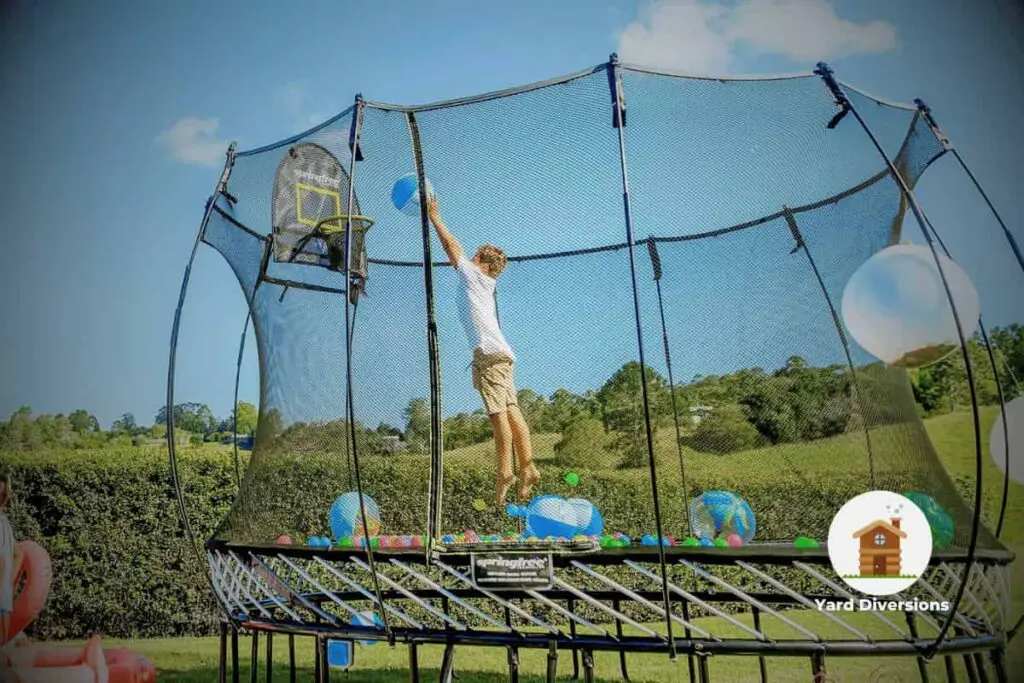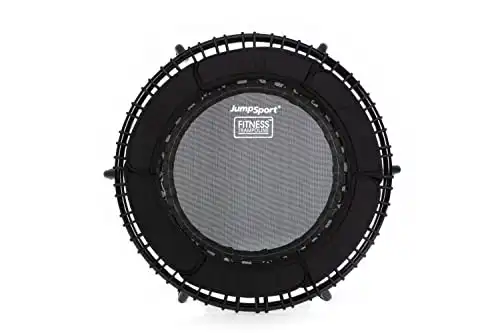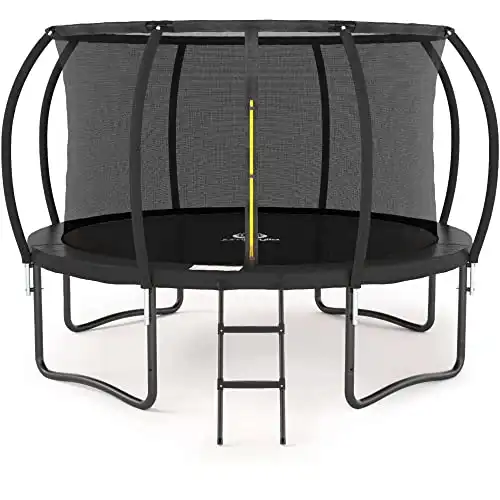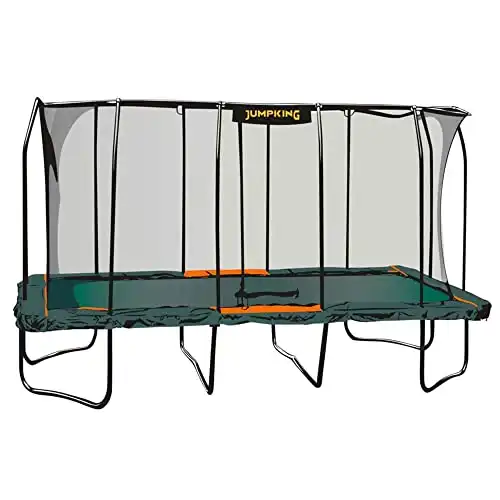Are the kids in your life ready for some outdoor fun? What better way to provide it than with a trampoline? As a lover of trampolines for fun and fitness, I’m always here to help you make the best decisions possible. That’s why I’ve put together this comprehensive trampoline buying guide.
This guide will cover everything from types of trampolines and their sizes, features, and design elements to consider when purchasing, to safety tips, prices, and more.
Whether you have long-term plans for your backyard or just want something that can be taken down after use, this guide has something for everyone.
It doesn’t matter if you’re a rookie or an experienced buyer – there’s plenty of useful information packed into this guide that’ll help take the guesswork out of shopping around for the perfect trampoline!

Types of Trampolines
When it comes to trampolines, there are a few different types available. The type you choose will depend largely on your intended use and space constraints. Here are the most common types of trampolines and some information about them:
Mini Trampolines: Mini trampolines, also known as rebounders, are smaller than standard models and designed for indoor or outdoor use. They usually have an integrated handlebar to help you keep your balance while bouncing. They’re perfect for low-impact exercise such as aerobic workouts or general fitness activities.
Standard Trampolines: Standard trampolines come in a variety of sizes ranging from 8-14 feet in diameter and can be used both indoors and outdoors. These models are suitable for recreational fun as well as athletic training purposes, with ample room to accommodate multiple jumpers at once (assuming they all weigh under 250 lbs).
Rectangular Trampolines: Rectangular trampolines offer more stability than round models due to their larger jumping surface which is supported by two longer sides instead of one circular frame. As a result, these are often preferred by gymnasts who need plenty of space to practice certain skills safely – although bear in mind that rectangular models tend to take up quite a lot of backyard real estate!
Mini Trampolines
Mini trampolines, also known as rebounders, are a perfect choice for those who have limited space. These small trampolines usually measure around 40 inches in diameter and are designed to be used indoors or outdoors.
Mini trampolines are ideal for low impact exercises such as yoga, Pilates and jumping jacks. They can also be used by children or adults who just want to have a bit of fun bouncing around.
The frame structure on mini trampolines is typically made from steel tubing that has been powder coated to protect against rusting. The springs that attach the jumping mat to the tubing are typically coiled springs made from galvanized steel wire.
Safety features on mini trampolines can vary depending on the model you purchase but most will include foam padding along the edge of the frame and an enclosure net around the perimeter of the mat.
It’s important to note that these safety features may not provide adequate protection if your mini trampoline is intended for use by multiple people at once or with high-intensity jumps over long periods of time – this type of bouncer should only be used by one person at a time in order to avoid injury.
The jumping mats on mini trampolines are usually made from polypropylene which is durable enough for light exercise but doesn’t stand up well under weighty jumps or continual abuse (for example kids playing tag!).
Get ready to transform your body with this Low-Impact Total-Body Exercise trampoline! Burn calories, blast fat, and get stronger while having more fun than ever before.
Make sure you read through any manufacturer’s instructions before using your mini-trampoline so you know what it’s meant for and how best to care for it in order to get many years out of it! Most come with a warranty ranging between 6 months up till 5 years – so make sure you check this too before purchasing!
Standard Trampolines
Standard trampolines are the most popular type of trampoline on the market. They come in various shapes and sizes, but typically have a round shape with four legs.
The frame is generally made from either galvanized or powder-coated steel, while the jumping mat is usually constructed from a heavy-duty material such as polypropylene or PVC.
Standard trampolines also come with safety features like impact-absorbing padding and an enclosure net to protect jumpers from hitting the frame, as well as providing extra stability.
Lastly, these trampolines typically feature up to 8 galvanized springs for maximum bounce power and durability.
When it comes to size, standard trampolines can range anywhere from eight feet all the way up sixty-eight feet in diameter, so there’s sure to be something that fits your needs!
Rectangular Trampolines
Rectangular trampolines are becoming an increasingly popular choice due to their size and stability. They can be used for a variety of activities, such as gymnastics, sports training, or just simply bouncing around.
Rectangular trampolines tend to be larger than standard round ones and are often designed specifically for gymnastics.
The rectangular design provides more room for multiple users or for bigger jumps and flips since there is more space available.
The frame itself is typically stronger than a round shape, allowing it to hold more weight without compromising the strength of the structure or its safety features.
The jumping mat material on rectangular trampolines usually consists of thicker polypropylene fabric with UV protection that can withstand wear and tear over time.
This makes them ideal for athletes who use them regularly as they require minimal maintenance but still provide enough bounce and support during activities like tumbling.
Rectangular trampolines also generally have higher spring counts compared to other types; this means they offer increased jump heights and make landings more comfortable by absorbing most of the impact before you hit the ground surface. Additionally, because these trampoline frames are usually longer, they require fewer springs so it’s cheaper in terms of cost per square foot compared to traditional round designs.
Trampoline Size
When it comes to size, there are a variety of options ranging from mini trampolines to large rectangular trampolines. The size you choose will depend on the amount of space you have available and how many people will be using the trampoline at once.
Mini trampolines are great for small spaces as they typically measure between 36-48 inches in diameter and can support up to 220 lbs.
Standard round trampolines measure 8 feet in diameter and can accommodate multiple users, while rectangular trampolines offer an even larger jumping surface that is perfect for gymnastics training or backyard parties.
If you don’t have a lot of space or just want a smaller option, consider foldable mini-tramps which can easily be stored away when not in use.
But if you plan on having multiple people use your trampoline, then try to opt for the largest size possible within the confines of your space – this way everyone can enjoy bouncing around without having to worry about knocking into each other!
Frame Structure
When it comes to trampoline frames, you generally have two types of materials to choose from: galvanized steel and powder-coated steel.
Both provide a great deal of stability and strength for the trampoline, but each has its own unique benefits that should be considered when choosing a frame.
Galvanized Steel Galvanized steel is the most common type of material used in trampoline frames. It is very strong and durable, offering several advantages such as corrosion resistance and weather-proofing.
Furthermore, galvanized steel can be painted in order to give your trampoline an aesthetically pleasing look.
Powder-Coated Steel Powder-coated steel is another popular choice when it comes to trampoline frames. This type of coating provides extra strength as well as protection against rusting or corrosion.
Additionally, powder-coated steel frames are more durable than those made from galvanized steel because they are less prone to chipping or cracking over time.
Both galvanized steel and powder-coated steel offer excellent structural support for your trampoline, but one may suit your needs better than the other depending on various factors such as climate conditions in your area or personal preference regarding aesthetics.
Galvanized Steel
Galvanized steel trampolines are the most common type of frame used in trampolines. They’re made by dipping steel tubing into a hot zinc bath, which coats the tubing and helps to protect it from rust and corrosion. This makes them an ideal choice for outdoor use, as they will generally last longer than other types of frames in wet or humid conditions.
The downside to galvanized steel frames is that they tend to be heavier than other materials and can also be more expensive. However, with proper maintenance, they should last you many years before you need to replace them.
When buying a galvanized steel trampoline, make sure it has been coated with a protective layer that is specifically designed for outdoor use. This will help prevent oxidation due to exposure to water and sunlight, which can weaken the frame over time if left unprotected.
In addition, check how thick the tubing is on your galvanized steel trampoline; thicker tubing tends to be stronger and more durable than thinner tubes so look for models that have at least 34mm thick walls or even thicker if possible.
It’s also important to look at how many layers of coating are applied; ideally you should choose one with two or three layers for increased durability and protection against rusting or corrosion over time.
Powder Coated Steel
Powder-coated steel is one of the most popular materials used in trampoline frames. The powder coating process involves applying a thin layer of plasticized material to the metal frame, which helps protect it from rust and corrosion.
In addition, this type of frame is typically lighter in weight than galvanized steel, making it easier to maneuver and set up.
The biggest advantage of a powder coated steel trampoline is that it’s more durable than other materials due to its protective layer. This means that your trampoline should be able to withstand harsh weather conditions and last for many years without needing repairs or replacement parts.
However, there are some potential drawbacks associated with powder coated steel trampolines as well. While they’re more resistant to rust and corrosion than other types of frames, they may not always be as strong or stable as galvanized steel frames due to their lighter build.
Additionally, if left outside for long periods of time without proper maintenance or care, the plasticized material on the frame may start to wear away over time which can leave your trampoline susceptible to damage from UV rays and other elements.
For those looking for a lightweight yet durable option when buying a new trampoline, powder coated steel is an excellent choice that provides great protection against both rust and corrosion while still offering stability during use.
Just make sure you give your trampoline plenty of TLC so it can last you through many seasons!
Safety Features
When it comes to trampolines, safety is of the utmost importance. Fortunately, there are a number of features that can help keep your family safe while using their trampoline.
Padding: Look for trampolines with thick padding covering the springs and metal frame to reduce potential injuries in case of any falls. Make sure all pads are securely attached and free of tears or defects.
Enclosure Nets: It’s also important to find a trampoline with an enclosure net around the outside of the jumping surface. This will help prevent any falls off the trampoline and onto surrounding hard surfaces like concrete patios or wood decks as well as create an enclosed area where only one jumper can jump at a time which reduces risks for collisions between multiple users.
When looking for a trampoline, look for options that feature quality nets made from weather-resistant materials such as mesh fabric or PVC-coated nylon/polyester fabrics with strong stitching along seams and heavy-duty zippers for easy access into the enclosure area.
Additionally, make sure these nets have tension straps on each side so they remain taught and secure even when stressed by multiple jumps or external wind forces.
Padding
When it comes to trampolines, padding is an important safety feature. It serves as a protective barrier between the user and the frame, springs, and other components of the trampoline.
Padding should always fully cover any exposed metal or moving parts that can cause injury in the event of a collision with them.
Look for trampolines that have thick, durable padding made from high-quality materials such as EPE foam or vinyl.
The padding should be securely fastened to the frame so that it does not become loose over time due to use and wear and tear.
The best way to make sure your trampoline’s padding stays secure is by regularly inspecting it for signs of deterioration or damage.
When shopping for a new trampoline, always look out for models that come with additional safety features such as anti-slip surfaces on top or adjustable enclosure nets for added protection from falling off the sides of the mat during use.
These extra features ensure better protection without compromising on user experience while bouncing on your brand new trampoline!
Enclosure Nets
Enclosure nets are an important safety feature that should be considered when purchasing a trampoline. They are designed to keep the user safe by containing them within the boundaries of the trampoline, and preventing them from bouncing off or falling out.
Enclosure nets can also help reduce noise pollution in your backyard, as they absorb most of the sound waves created by jumping on a trampoline. This is especially helpful if you live in close proximity to neighbors who might be disturbed by excessive noise coming from your backyard!
Enclosure nets come in two main types: those with poles and those without poles. Poles provide additional support for enclosure nets, making them more stable than those without poles. However, they may take up more space in your yard and require additional setup time.
When shopping for an enclosure net, make sure you check that it is made from durable material such as UV-resistant nylon or polyester mesh fabric to ensure it lasts through weathering and regular use.
Additionally, look for one that has reinforced stitching and high-quality materials so it can withstand strong impacts without tearing or breaking easily.
Finally, check that all parts are included with the net so you won’t have any missing pieces when setting up your trampoline!
Jumping Mat Material
The jumping mat material is an important factor to consider when purchasing a trampoline. Generally, you want to look for a mat made of high-quality materials that are both durable and safe.
One of the most common types of jumping mats are polypropylene mats, which provide good elasticity and durability for bouncing. PVC mesh is also used in some models, as it provides greater tensile strength than polypropylene fabric while still offering decent bounce quality.
You should avoid jumping mats made from nylon or canvas, as these materials don’t offer enough cushioning for safety purposes. Additionally, make sure that the stitching on the edges of the mat is reinforced with double-stitching to ensure maximum stability and reduce wear over time.
Finally, check whether the mat comes with padding around its edges; having additional cushioning around the frame can help protect against injuries if someone falls off onto hard ground outside of the trampoline area.
Spring System
The spring system of a trampoline is incredibly important when it comes to determining the quality and bounce-ability of your trampoline. There are two main types of springs used on most trampolines: coil springs and enclosed spring systems.
Coil Springs: Coil springs, also called “hook springs”, are the traditional style trampoline spring which have been around for many years.
They are made with a steel wire that is bent into an arch shape, creating tension when stretched out.
The coils provide strong rebound, allowing users to jump higher and farther off the mat than they would be able to with other systems.
Enclosed Spring System: An enclosed spring system offers more protection from accidental contact or injury than coil springs because they are surrounded by protective pockets designed to keep people safe if they come in contact with them while jumping or falling off the trampoline.
This system also helps reduce noise caused by bouncing on the trampoline since it eliminates metal-to-metal contact between the frame and the coils themselves.
Enclosed systems usually offer a softer bounce than regular coil springs, making them better suited for young children who may not be able to handle a harsher jumping experience.
When evaluating different types of trampolines, make sure you pay close attention to what type of spring system each model has so you can choose one that provides enough bounce for your needs as well as sufficient safety measures in case somebody accidentally touches one while jumping or playing on it.
Coil Springs
Coil springs are the most commonly used type of springs on trampolines. These long, cylindrical springs provide a lot of bounce, and they’re also relatively easy to install and replace.
The main downside of coil springs is that they will eventually wear down over time, reducing the amount of bounce. It’s important to inspect your trampoline regularly for any signs of wear or broken coils.
If you find any defective parts, it’s essential to replace them immediately for your safety and the safety of others using your trampoline.
When shopping for replacement coil springs, make sure the length and diameter measurements match up with those specified by the manufacturer. Also pay attention to spring material – galvanized steel is more durable than plain steel but may cost more upfront depending on your budget.
Finally, avoid buying second-hand coils unless you know their exact specifications as there may be significant differences between different types or models which could lead to instability in future use.
Enclosed Spring System
An enclosed spring system is a great option for those who want the durability of steel springs, but with an added layer of safety. This type of system features a protective outer casing that encases the springs and helps to reduce risk of injury.
The enclosure typically consists of two components — a polypropylene netting and an extra-thick PVC pad which fits snugly over the springs. The combination of these elements provides not only cushioning for jumpers, but also keeps them away from exposed metal parts on the trampoline.
Enclosed spring systems are most often found on higher quality trampolines so it’s important to check the specs to make sure you’re getting what you pay for. To ensure maximum safety, be sure to look for one with thicker padding made out of UV-resistant material and more than six enclosure net poles at each corner post.
It’s always best practice to test out any trampoline before buying, even if it has an enclosed spring system. This will give you a better idea as to how comfortable and safe it feels when jumping around on it.
What Sizes of Trampolines are Suitable for Flipping?
When it comes to flipping on a trampoline, choosing the right size is crucial. To ensure safety and ample space for flips, consider trampoline sizes for flipping: essential tips. Opt for a larger trampoline with a minimum diameter of 10 feet to provide enough room for acrobatic maneuvers. Additionally, ensure that the trampoline has sufficient bounce to support your flipping skills.
Warranty
When shopping for a trampoline, one of the important factors to consider is the warranty. A good quality trampoline should come with some kind of warranty that guarantees that it will last for many years.
Some manufacturers offer lifetime warranties on their products so you can trust that your purchase will be protected in case anything were to happen. You should always look into what kinds of warranty coverage are offered and ask questions about any claims made by the manufacturer as well.
It’s also important to read through any fine print associated with a particular product’s warranty before making a decision.
Make sure all parts and components are covered, including frames, mats, nets, springs, padding, etc., and verify what types of scenarios fall under the terms of the warranty (e.g., normal wear-and-tear vs accidental damage).
Finally, keep in mind that while longer warranties provide more peace of mind when making a purchase decision they don’t necessarily guarantee higher quality products—so make sure you do your due diligence when researching different brands and models!
Are Expensive Trampolines Worth the Investment According to Your Comprehensive Buying Guide?
When considering the true cost of trampoline ownership, it’s important to weigh the upfront investment against the long-term benefits. Expensive trampolines may offer greater durability, safety features, and warranty coverage, making them a worthwhile investment for families looking for quality and peace of mind.
Conclusion
Choosing the right trampoline for you and your family can be a daunting task. Consider all of the factors discussed – size, type, frame structure, safety features, jumping mat material, and spring system – to make sure that you get a safe and enjoyable trampoline that will last for years!
Additionally, check with the manufacturer to make sure that they offer a good warranty so you can be protected should anything go wrong.
Doing research is key when it comes to buying a trampoline. It’s important to read reviews from other customers and figure out what works best for your needs. And don’t forget – always follow the safety guidelines laid out by the manufacturer!




